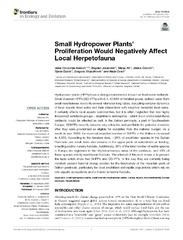Приказ основних података о документу
Small Hydropower Plants' Proliferation Would Negatively Affect Local Herpetofauna
| dc.creator | Crnobrnja-Isailović, Jelka | |
| dc.creator | Jovanović, Bogdan | |
| dc.creator | Ilić, Marija | |
| dc.creator | Ćorović, Jelena | |
| dc.creator | Čubrić, Tijana | |
| dc.creator | Stojadinović, Dragana | |
| dc.creator | Ćosić, Nada | |
| dc.date.accessioned | 2021-02-10T14:00:35Z | |
| dc.date.available | 2021-02-10T14:00:35Z | |
| dc.date.issued | 2021 | |
| dc.identifier.issn | 2296-701X | |
| dc.identifier.uri | https://www.frontiersin.org/articles/10.3389/fevo.2021.610325/full | |
| dc.identifier.uri | https://radar.ibiss.bg.ac.rs/handle/123456789/4136 | |
| dc.description.abstract | Hydropower plants (HPPs) have a strong environmental impact on freshwater wetlands. Small diversion HPPs (SDHPPs) with 0.1–10 MW of installed power, redirect water from small mountainous rivers into several-kilometer-long tubes, disrupting complex dynamics of local aquatic food webs and their interactions with neighbor terrestrial food webs. It certainly affects local aquatic communities, but it is often neglected that two highly threatened vertebrate groups—amphibians and reptiles—which live in and around these wetlands, could be affected as well. In the Balkan peninsula, a part of Southeastern Europe, SDHPPs recently became very attractive and profitable for potential investors after they were proclaimed as eligible for subsidies from the national budget. As a result, in year 2020, the maximal projected number of SHPPs in the Balkans increased to 4,556. According to the literature data, ~28% of amphibian species in the Balkan Peninsula use small rivers and streams in the upper parts of watersheds as feeding, breeding and/or nursery habitats. Additionally, 38% of the total number of reptile species in Europe are registered in the hilly/mountainous areas of the peninsula, and 33% of these species strictly need humid habitats. The attempt of this mini-review is to present the facts which show that SHPPs and DSHPPs, in the way they are currently being installed, present harmful energy solution for the biodiversity of the mountain parts of Balkan peninsula, particularly for local amphibian and reptile populations which rely on lotic aquatic ecosystems and/or humid terrestrial habitats. | |
| dc.publisher | Frontiers | |
| dc.relation | info:eu-repo/grantAgreement/MESTD/inst-2020/200007/RS// | |
| dc.relation | info:eu-repo/grantAgreement/MESTD/inst-2020/200124/RS// | |
| dc.relation | Fulbright Short-Term Scholar Grant No. G-1-00005 for 2018/19 | |
| dc.rights | openAccess | |
| dc.rights.uri | https://creativecommons.org/licenses/by/4.0/ | |
| dc.source | Frontiers in Ecology and Evolution | |
| dc.subject | Balkan peninsula | |
| dc.subject | Europe | |
| dc.subject | Herpetofauna | |
| dc.subject | Impact | |
| dc.subject | Local biodiversity | |
| dc.subject | Small diversion hydropower plants | |
| dc.subject | Small hydropower plants | |
| dc.title | Small Hydropower Plants' Proliferation Would Negatively Affect Local Herpetofauna | |
| dc.type | article | en |
| dc.rights.license | BY | |
| dcterms.abstract | Ћосић, Нада; Јовановић, Богдан; Црнобрња-Исаиловић, Јелка; Чубрић, Тијана; Стојадиновић, Драгана; Ћоровић, Јелена; Илић, Марија; | |
| dc.rights.holder | © 2021 Crnobrnja-Isailović, Jovanović, Ilić, Ćorović, Čubrić, Stojadinović and Ćosić. | |
| dc.citation.volume | 9 | |
| dc.identifier.doi | 10.3389/fevo.2021.610325 | |
| dc.identifier.wos | 000621548100001 | |
| dc.citation.apa | Crnobrnja-Isailović, J., Jovanović, B., Ilić, M., Ćorović, J., Čubrić, T., Stojadinović, D., et al. (2021). Small Hydropower Plants’ Proliferation Would Negatively Affect Local Herpetofauna. Frontiers in Ecology and Evolution, 9, 610325. | |
| dc.citation.vancouver | Crnobrnja-Isailović J, Jovanović B, Ilić M, Ćorović J, Čubrić T, Stojadinović D, Ćosić N. Small Hydropower Plants’ Proliferation Would Negatively Affect Local Herpetofauna. Front Ecol Evol. 2021;9:610325. | |
| dc.citation.spage | 610325 | |
| dc.type.version | publishedVersion | |
| dc.identifier.fulltext | https://radar.ibiss.bg.ac.rs/bitstream/id/8167/fevo-09-610325.pdf | |
| dc.citation.rank | M21 |

